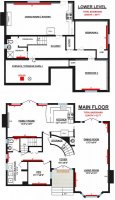When you mentioned that the manual said the minimum firing output is 46,400 BTU, what exactly does that mean?....especially in comparison to the 151,000 BTU advertised on the unit?
There are lots of variations on the them for the Greenstar Combi models so I may have been looking too quickly. I believe the one closest to yours is specified on
page 25 of this technical spec document. This has a modulating burner- it ramps the flame up and down with load. The maximum INPUT rate is 151,600 BTU/hr for the natural gas version, and 148,300 BTU/hr. But the MINIMUM input rate is 36,000 BTU/hr (NG) or 46,400 BTU/hr (LPG).
The minimum output at
condensing temperatures (the 122/86 °F (50/30 °C) row) is 35,100 BTU/hr (NG) or 46,100 BTU/hr (LPG).
The smallest independently controlled zone being only 38' means that to get condensing temperature ideally the minimum firing rate of the boiler would be 38' x 200 BTU/hr = 7600 BTU/hr. Anything more than that it will cycle on/off during continuous calls for heat, since the burner can't turn down any lower. The 35,100 BTU/hr minimum output of the Greenstar 151 is more than four times that- it's going to short cycle like crazy. Even with the full 99 feet of baseboard operating at one zone it can't run at condensing temperatures without a lot of cycling, since the 99' of baseboard would only be emitting ~20K of that 35K minimum output, with 15K of surplus heat causing the system temperatures to rise quickly, since there isn't much water volume or other thermal mass to work with. That boiler would be a
disaster on your system.
Without reviewing the load line by line (looks fine on a quick review). A slope of 743.8 BTU per degree F is a credible number for a ~2000' hous over a ~1000 basement. Based on your thermostat settings it's reasonable to use base 65F for the heat load analysis, so you're looking at a design load of ~30.5K, and could reasonably use up to ~43K of burner output to cover cold snaps. Anything over that is fine (even though it is never needed for space heating), as long as at minimum fire it can modulate down to the 7600 BTU/hr range or lower.
Notice that the Greenstar 151's minimum firing rate is more than your actual design heating load, which is what I expected.
HTP's
UFT-080W boiler (also sold under the Westinghouse label as the WBRUNG-080W) plus an indirect water heater would be an easy choice here, but I'm not sure how well supported it is in Canada. That boiler can throttle down to about 7600 BTU/hr in condensing mode, but can also ramp up to 75,000 BTU/hr when serving the water heater for very short recovery times. From a system design perspective it's easier than most, since it has a pre-plumbed secondary port for the water heater along with some other controls built-in, and it's pretty forgiving on flow-rates through the boiler.
Navien's
NHB-055 also ramps down that low 8000 BTU/hr-in/7600 BTU/hr out at minimum fire, and is widely available in Canada. That size would be fine for space heating, but would have a slower recovery time for the water heater than the UFT-080W. But her slightly bigger sister the
NHB-80 has the same minimum firing rate as the -055, and ramps up to the same maximum as the UFT-080W, making it my #2 choice for your system.
A primary difference between the UFT-080W and NHB-80 is the heat exchanger type, and water volume. The NHBs have very low volume higher pumping-head water tube type heat exchangers, whereas the UFTs have about 25lbs of water in them and much lower pumping head. From a system design point of view the NHBs
must get plumbed primary/secondary, which knocks a percent or two off the as-used efficiency due to the slightly higher water temp entering the boiler from the hydraulic separator (Navien sells a pre-engineered manifold to be used as that hydraulic separator), whereas in most systems the UFTs can be pumped direct, where the boiler is taking the full flow of the radiation zones. That may read like Urdu to you, but it's nothing to be concerned about if you trust the competence of the installers.
Lochinvar's
WHB-055 and WHB085 would also work fine here, but they're usually more expensive than the Naviens & HTPs. The WHBs have more bells & whistles to program than you'll ever need on a heating system as simple as yours. Their somewhat simpler
NKB080 would be just fine.
There are other condensing boilers that would still work optimally, but none of them are combi-boilers. The
Laars Mascot FTs use the exact same heat exchanger as the UFTs (they are both designed and built by Kiturami a first-tier Korean boiler manufacturer), but for some reason the MFTHW80 only modulates down to 16K-in 15.2K out, which could be a problem when only the basement zone is calling for heat.

